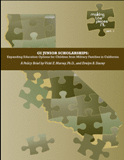New policy brief finds that providing military families with school vouchers to allow parents to choose schools that best fit their children’s needs would raise educational achievement and save the state money.

Sacramento— Today, the Pacific Research Institute (PRI), a California-based public policy think tank, released a policy brief on improving education opportunities for school-aged military children in California. GI Junior Scholarships: Expanding Education Options for Children from Military Families in California, by Vicki E. Murray, Ph.D., PRI associate director of Education Studies, and Evelyn B. Stacey, policy fellow, finds that providing military families with school vouchers to allow parents to choose schools that best fit their children’s needs would raise educational achievement and save the state money.
With more than 200,000 Active Duty and Selected Reserve members, California leads the nation in military population. Military children attend an average of six to nine different school systems throughout their elementary and high school years. In addition to the stress of parents being frequently deployed, military children are often forced to make sacrifices in their education as well:
- Overall, school districts surrounding military bases throughout California have a slightly lower Academic Performance Index (API) than the statewide average.
- Overall, only about half of students in public schools surrounding California’s 26 military bases score at the “proficient” level in English language and math on the California Standards Test.
- Barely 14 percent of high school students in those schools on average score college-ready in English on the Early Assessment Program; while just 9 percent score college-ready in math.
“It’s entirely reasonable that military parents, who have little to no control over where they will be stationed should command more choice over the education of their children,” said Dr. Murray. “Expanding private education options for students from military families by allowing students to attend private schools using public funds would help ensure they have access to high-quality schools regardless of where their parents are stationed.”
The cost of educating the school-age military children in California public schools is more than $1.1 billion annually. Allowing those same students to use GI Junior Scholarships worth just a portion of their state and local education funding would expand their education options and yield significant annual savings—an estimated $547 million annually.
“Our soldiers, sailors, airmen, and Marines deserve the best educational opportunities for their families,” concluded Dr. Murray, “There are affordable, and even cost-saving options to improve these opportunities if we embrace school choice and ensure that families can select the best school for their kids when moving in and out of school systems while fulfilling their civic duty.”
